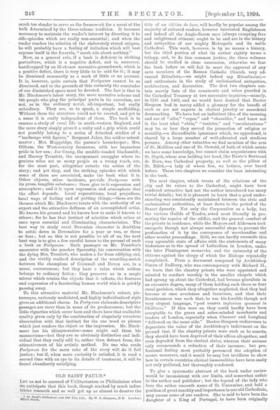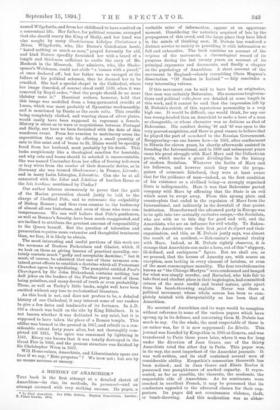OLD SAINT PAUL'S.* LET us not be accused of Utilitarianism
or Philistinism when we anticipate that this book, though marked by much indus- trious research and so well got up as almost to deserve the • St Paul's Cathedral and Oki City Life. By W. S. Simpson, D.D. London: talliot Stook. title of an edition de luxe, will hardly be popular among the majority of cultured readers, however interested Englishmen and indeed all the Anglo-Saxon race (always excepting free and enlightened citizens) ought to be and are in the history and antiquities of our mighty Metropolis and its noble Cathedral. This work, however, is by no means a history, but the third portion of what its author rightly terms a trilogy, and, to do him common justice, the three volumes should be studied in close succession, otherwise we fear the book before us will fail to meet the approval of any save members of the Roman Catholic Church, very ad- vanced Ritualists,—we might indeed say Ritualissimi,— and enthusiasts in the study of ecclesiastical antiquities, architecture, and decoration. The first two chapters con- tain merely lists of the ornaments and robes guarded in. the Cathedral Treasury at two successive inquiries,—namely, in 1245 and 1402, and we would have desired that Doctor Simpson had in mercy added a glossary for the benefit of such as are not experts in clerical jewelry or sacerdotal dressmaking. We have but an indistinct idea of the meaning and use of "albs," "copes," and "chasubles," and know not in the least what "obits," " tonicles," and " osculatoriums " may be, or how they served the promotion of religion or morality,—a discreditable ignorance which, we apprehend, is shared by a large number of well-educated and studious persons. Among other valuables we find mention of the arm of St. Mellitus and one of St. Oswald, of both of which saints we have some knowledge, but cannot claim acquaintance with St. Osyth, whose arm holding her head, like Dante's Bertrand de Born, was Cathedral property, as well as the pillow of St. Edith,—a lady of whom few, we believe, ever heard before. These two chapters we consider the least interesting in the book.
The next chapter, which treats of the relations of the city and its rulers to the Cathedral, might have been rendered attractive had not the author introduced too many trivial details ; but it is pleasant to learn that a good under- standing was consistently maintained between the civic and ecclesiastical authorities, at least down to the period of the Stuart dynasty. Not only the Corporation as a body, but the various Guilds of Trades, acted most liberally in pro- moting the repairs of the edifice, and the general comfort of the priests in residence, while the Mayors and Aldermen took energetic though not always successful steps to prevent the profanation of it by the conveyance of merchandise and other secular proceedings. Still, we can hardly reconcile this very agreeable state of affairs with the statements of many historians as to the spread of Lollardism in London, under the later Plantagenet monarchs, and the animosity of the citizens against the clergy of which the Bishops repeatedly complained. From a document composed by Archbishop Simon of Sudbury, who was contemporary with Richard II., we learn that the chantry priests who were appointed and salaried to conduct worship in the smaller chapels which had sprung up about the Cathedral, had become pluralists in an excessive degree, many of them holding each three or four rural parishes, which they altogether neglected, that they had become at once avaricious and luxurious, and that their licentiousness was such that, to use his forcible though not very elegant language, "post ventris ingluviem spumant in libidinem." If this were so, they could hardly have been acceptable to the grave and sober-minded merchants and traders of London, especially when Chaucer and Langland " followed on the same side." Doctor Simpson endeavours to depreciate the value of the Archbishop's indictment on the ground that if the chantry priests were such as he asserts, they should have been deprived of their offices altogether, and even degraded from the clerical status, whereas their accuser only recommends a reduction of their incomes ; but pro- fessional feeling most probably prevented the adoption of severe measures, and it would be easy but invidious to show how in certain countries clerical immoralities have been easily not only palliated, but thoroughly condoned.
To give a systematic abstract of the book under review would be inconsistent with our limits, and somewhat unfair to the author and publisher ; but the legend of the lady who bore the rather uncouth name of St. Unoumber, and held a position of great sanctity and importance in our old Cathedrals, may amuse some of our readers. She is said to have been the daughter of a King of Portugal, to have been originally named Wilgefortis, and from her childhood to have resolved on a conventual life. Her father, for political reasons, arranged that she should marry the King of Sicily, and her hand was also sought by many illustrissimos hidalgos Okrislianoe y Moron. Wilgefortis, who, like Burns's Caledonian lassie, " hated nothing so much as men," prayed fervently for aid, and kind Nature speedily furnished her with a beard of a length and thickness sufficient to excite the envy of Mr. Moshesh in the Minoresh, Her admirers, who, like Shake- speare's Welshman, could not abide " a 'ooman with a peard," at once declared off; but her father was so enraged at the failure of his political schemes, that he doomed her to be crucified. She had a special chapel in the Cathedral, where her image (bearded, of course) stood until 1538, when it was removed by Royal order, "that the people should do no more idolatry unto it." Heretical writers, however, hold that this image was modelled from a long-garmented crucifix at Lucca, which was most probably of Byzantine workmanship, and is mentioned by Dante as the canto volto. This crucifix being completely clothed, and wearing shoes of silver plates, would easily have been supposed to represent a female. History is silent as to wars or negotiations between Portugal and Sicily, nor have we been furnished with the date of this wondrous event. From her aversion to matrimony arose the superstition that any wife by offering a small quantity of oats to this saint and of beans to St. Blaise would be speedily freed from her husband, most probably by his death. This looks suspiciously like a theological sanction for homicide, and why oats and beans should be selected is unaccountable. She was named Unoumber from her office of freeing toil-worn or lazy wives from the cumber of their domestic duties, as in Germany she was termed Ohnkummer ; in France, Livrade ; and in many Latin Liturgies, Liberatrix. Can she be at all connected with the Liber and Libitina of heathen Rome or the Ze6; btovBiploc mentioned by Pindar Our author labours strenuously to prove that the guilt of the Marian persecution should justly be laid to the charge of Cardinal Pole, and to extenuate the culpability of Bishop Bonner ; and thus runs counter to the testimony of almost all our historians, and even of those who were con- temporaneous. We can well believe that Pole's gentleness, as well as Bonner's ferocity, have been much exaggerated, and are inclined to attribute the greatest amount of responsibility to the Queen herself. But the question of toleration and persecution requires more extensive and thoughtful treatment than, we fear, it is likely to obtain. The most interesting and useful portions of this work are the sermons of Doctors Feokenham and Glacier, which, if we look on them as giving lessons of practical morality, cer- tainly contain much "godly and acceptable doctrine; " but it must, of course, be admitted that one of these sermons con- tained great efforts to establish a dootrine which all Protestant Churches agree in repudiating. The pamphlet entitled Paul's Churchyard, by Sir John Birkenhead, contains nothing but dull jokes on the leaders of the Puritan party, most of them being pointless, and many devoid of truth or even probability. These, as well as Farley's little books, might well have been omitted without any loss to ecclesiastical literature.
As this book is not, and does not profess to be, a detailed history of our Cathedral, it may interest some of our readers to give a few dates and landmarks of its fortunes. In A.D. 610 a church was built on the site by King Ethelbert. It is not known whether it was dedicated to any saint, but it is supposed to have taken the place of a Roman temple. This edifice was burned to the ground in 1087, and rebuilt to a con- siderable extent forty years after, but not thoroughly com- pleted till 1315. The spire was consumed by lightning in 1561. Every one knows that it was totally destroyed in the Great Fire in 1666, and the present structure was finished by Sir Christopher Wren in 1697.
Will Home-rulers, Anarchists, and Liberationists spare our lives if we say, " Esto perpetua " ? We trow not ; but are by no means nervous or uneasy.



































 Previous page
Previous page